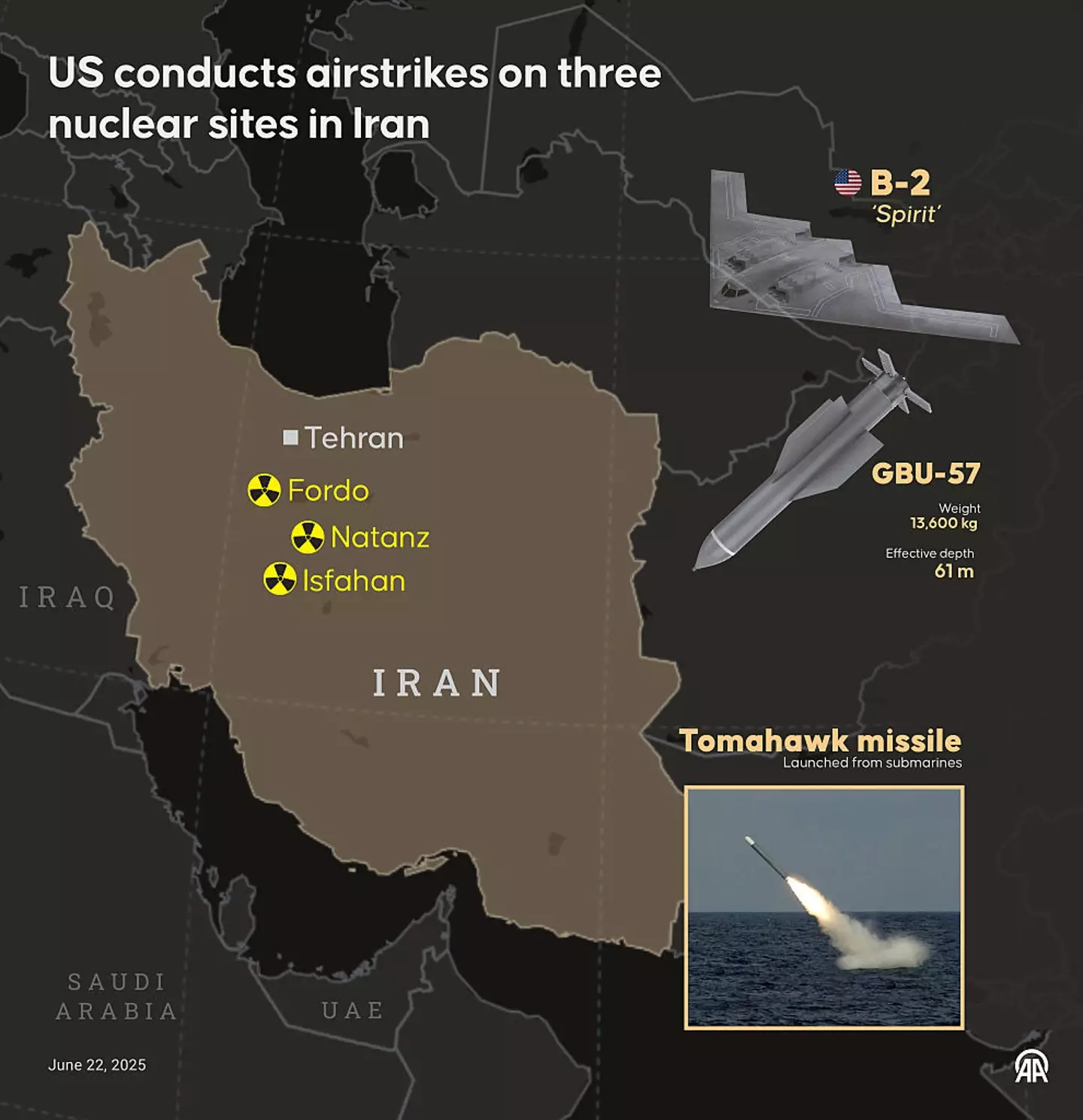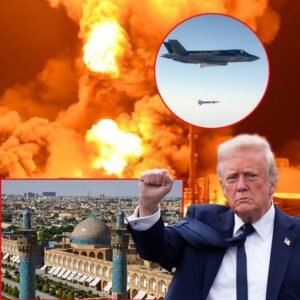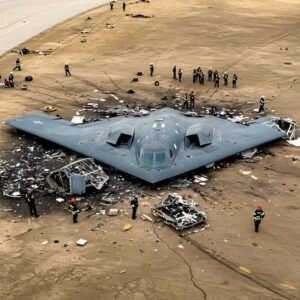In the arena of international politics, decisions made in secret war rooms and high-level diplomatic meetings often ripple far beyond their immediate targets. These moments are not always immediately understood by the general public, nor are they always transparent in motive. But their consequences, when they surface, can redefine the future of nations, alliances, and global peace. A recent event has reignited debates around power, preemptive action, and the shadow of nuclear conflict.
An Announcement That Shook the Globe
What began as routine chatter among foreign correspondents quickly evolved into a full-scale media frenzy. The headlines hit like a thunderclap: the United States had launched coordinated airstrikes on three major nuclear sites within Iranian borders. The declaration came not through traditional diplomatic channels, but through a digital address from President Donald Trump, posted to his social platform.
The announcement was timed at 7:50 PM Eastern Time and quickly made waves around the world. In it, Trump stated that the United States had completed what he described as a “very successful attack” on three significant Iranian nuclear sites: Fordow, Natanz, and Esfahan. According to the president, the strikes were intended to halt what he called Iran’s “horribly destructive enterprise.”
A Presidential Message With Sharp Edges
President Trump didn’t mince words during his follow-up national address. In front of a somber backdrop, he delivered a stark warning, not just to Iran but to the global community. He emphasized that the aim of the airstrikes was to eliminate Iran’s nuclear enrichment capacity and neutralize what he referred to as the “nuclear threat posed by the world’s number one state sponsor of terror.”
“Iran’s key nuclear enrichment facilities have been completely and totally obliterated,” he asserted. “Iran, the bully of the Middle East, must now make peace. If they do not, future attacks will be far greater and a lot easier.”
The language was fiery, designed not just to communicate success but to deter any form of retaliation. The president’s rhetoric echoed a long-standing posture of strength, yet it also introduced an undeniable uncertainty into the global geopolitical climate.
Iran’s Response: Swift, Furious, and Defiant
It didn’t take long for Iran to respond. Within hours, Foreign Minister Seyed Abbas Araghchi issued a public statement on Twitter, condemning the strikes as a flagrant violation of international law.
“The events this morning are outrageous and will have everlasting consequences. Each and every member of the UN must be alarmed over this extremely dangerous, lawless and criminal behavior,” he wrote. He further emphasized Iran’s sovereign right to defend itself, referencing provisions under the United Nations Charter.
The Iranian government made it clear that it considered the attacks an act of aggression. International law, according to Araghchi, had been trampled, and Tehran would reserve the right to respond in kind.

Infographic of the US’ bombing of Iran’s key nuclear sites (Murat Usubali/Anadolu via Getty Images)
Military Mobilization and Strategic Movement
Even before the strike became public knowledge, indicators suggested something significant was underway. Observers spotted three U.S. stealth bombers departing American air bases and heading toward Diego Garcia, a strategically located island in the Indian Ocean used by both the UK and U.S. for military operations.
This movement, coupled with rising intelligence chatter, hinted at an impending operation. What was unclear at the time, however, was the scale and the target. That is, until the early morning explosions across Iran made the situation unambiguously clear.
Iran’s Nuclear Capabilities: A Long-Brewing Concern
At the heart of this crisis lies Iran’s long-contentious nuclear program. While Tehran has consistently claimed its program is for peaceful energy development, international watchdogs and intelligence agencies have raised serious concerns.
Central to these concerns is Iran’s uranium enrichment. Natural uranium contains only about 0.7% of the isotope uranium-235, which is insufficient for most energy and weapon needs. Civilian nuclear reactors require enrichment levels of 3.5%, while weapons-grade uranium (WGU) requires 90% enrichment.
According to recent reports, Iran has been enriching uranium to 60% purity and stockpiling it in large quantities. Though still below the weapons-grade threshold, experts say this level means Iran has completed most of the work needed to reach weaponization.
The Watchdog Report That Changed Everything
The Institute for Science and International Security (ISIS), a well-respected nonprofit dedicated to nuclear monitoring, issued a chilling report on June 9 that detailed just how close Iran was to achieving a viable nuclear arsenal.
Their findings were unsettling. According to the report, Iran’s main enrichment site at Fordow was capable of producing 25 kg of WGU in just two to three days. Worse still, if enrichment occurred at both Fordow and Natanz simultaneously, Iran could produce enough material for:
- 11 nuclear weapons in the first month
- 15 by the end of the second month
- 19 by the end of the third month
- 21 by the fourth month
- 22 nuclear weapons by the fifth month
These projections transformed abstract fears into tangible timelines, lending urgency to U.S. decision-making.
Assessing the Damage: A Mixed Bag
Despite President Trump’s declaration of total destruction, early assessments from the International Atomic Energy Agency (IAEA) suggest a more nuanced outcome. The IAEA reported “no increase in off-site radiation levels” from the three targeted sites, suggesting that while infrastructure may have been damaged, nuclear material likely remained contained.
This raises key questions: Were the sites truly “obliterated,” or was the strike more symbolic than strategic? Or perhaps the operation’s real success lies in neutralizing machinery and software, rendering enrichment operations impossible without producing dangerous fallout.
The IAEA has promised further updates as more data becomes available, and satellite imagery is now being combed for visual confirmation of impact.
The Legal and Ethical Debate
Whether the strike was legally justified remains hotly debated. The U.S. government has framed the action as a preemptive strike in the name of global security, referencing the ISIS report as justification. Meanwhile, critics argue that the strikes were not sanctioned by the United Nations or Congress, raising constitutional and international concerns.
Iran’s leadership, citing the Non-Proliferation Treaty (NPT) and UN Charter, claims that the U.S. has committed an act of international aggression. This is further complicated by the fact that no direct attack on U.S. soil or assets had occurred prior to the strikes.
A Moment of Precedent
This is not the first time a nuclear site has been preemptively attacked. In 1981, Israel bombed Iraq’s Osirak reactor, drawing widespread condemnation but ultimately stalling Iraq’s nuclear ambitions. In 2007, Israel again struck a suspected reactor in Syria. Each time, the international community balked but eventually moved on.
Now, the U.S. finds itself following a similar path, one where military action is used to prevent a perceived future threat, even if it means stepping outside traditional diplomatic channels.
Global Reaction: A Divided Chorus
Reaction from global leaders has ranged from cautious support to outright condemnation. Allies such as the UK and France have remained mostly silent, while Russia and China have called emergency meetings with their UN delegations.
Within the European Union, calls for restraint dominate the conversation. Germany and Sweden have urged both sides to avoid further escalation, while NATO has not issued a formal statement, opting instead for behind-the-scenes diplomacy.
The Road Ahead: Escalation or Diplomacy?
The coming days will be crucial. Analysts warn of several possible scenarios:
- Iran retaliates militarily, either directly or via proxy forces, potentially igniting regional conflict.
- Cyber retaliation, targeting U.S. infrastructure or defense networks.
- Diplomatic pressure increases, with the UN possibly imposing sanctions or demanding accountability.
- Iran returns to the negotiating table, spurred by the damage inflicted and global pressure.
Domestic Fallout and the 2024 Elections
Back home, Trump’s decision is sure to become a pivotal point in the 2024 presidential campaign. Supporters view the strike as a bold and necessary action, asserting American dominance and protecting global security. Detractors warn of reckless aggression and potential entanglement in yet another prolonged conflict.
Several U.S. lawmakers have called for urgent briefings, demanding clarity on the operation’s authorization and long-term objectives. There is also concern over whether allies were informed in advance.
Conclusion: A Defining Moment in Global Affairs
This military operation, regardless of its immediate tactical success, has already become a defining moment in international relations. The decision to strike three of Iran’s most sensitive nuclear sites signals a dramatic shift in U.S. foreign policy. It underscores a willingness to act unilaterally, prioritizing rapid response over prolonged negotiation.
The full impact remains to be seen. What is clear is that the balance of power in the Middle East has been disrupted, perhaps irreversibly. Whether this leads to renewed peace talks, further militarization, or unintended consequences will depend largely on the actions taken in the next critical days.
One message echoes through capitals across the globe: the nuclear question is not theoretical. It is here. It is now. And it demands answers.





